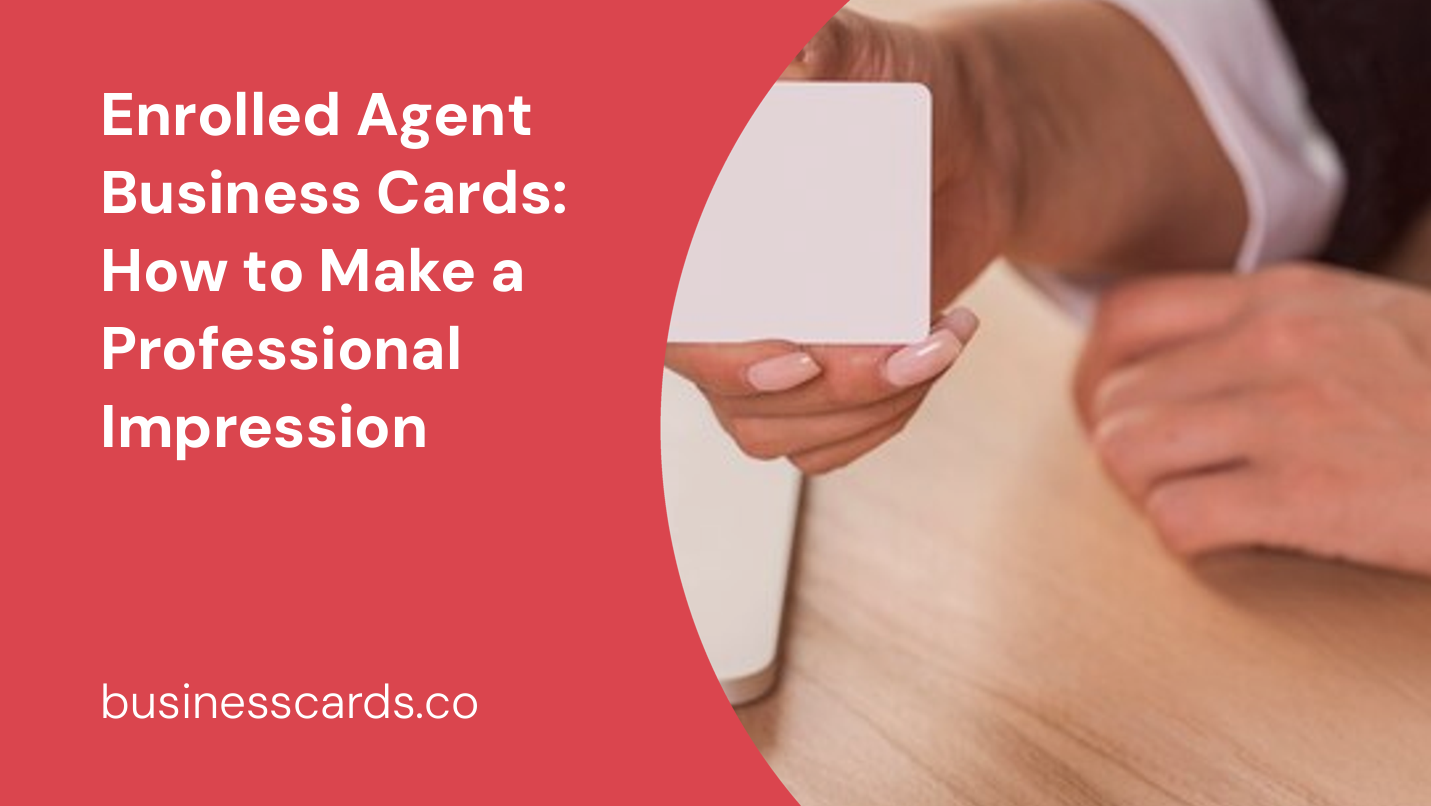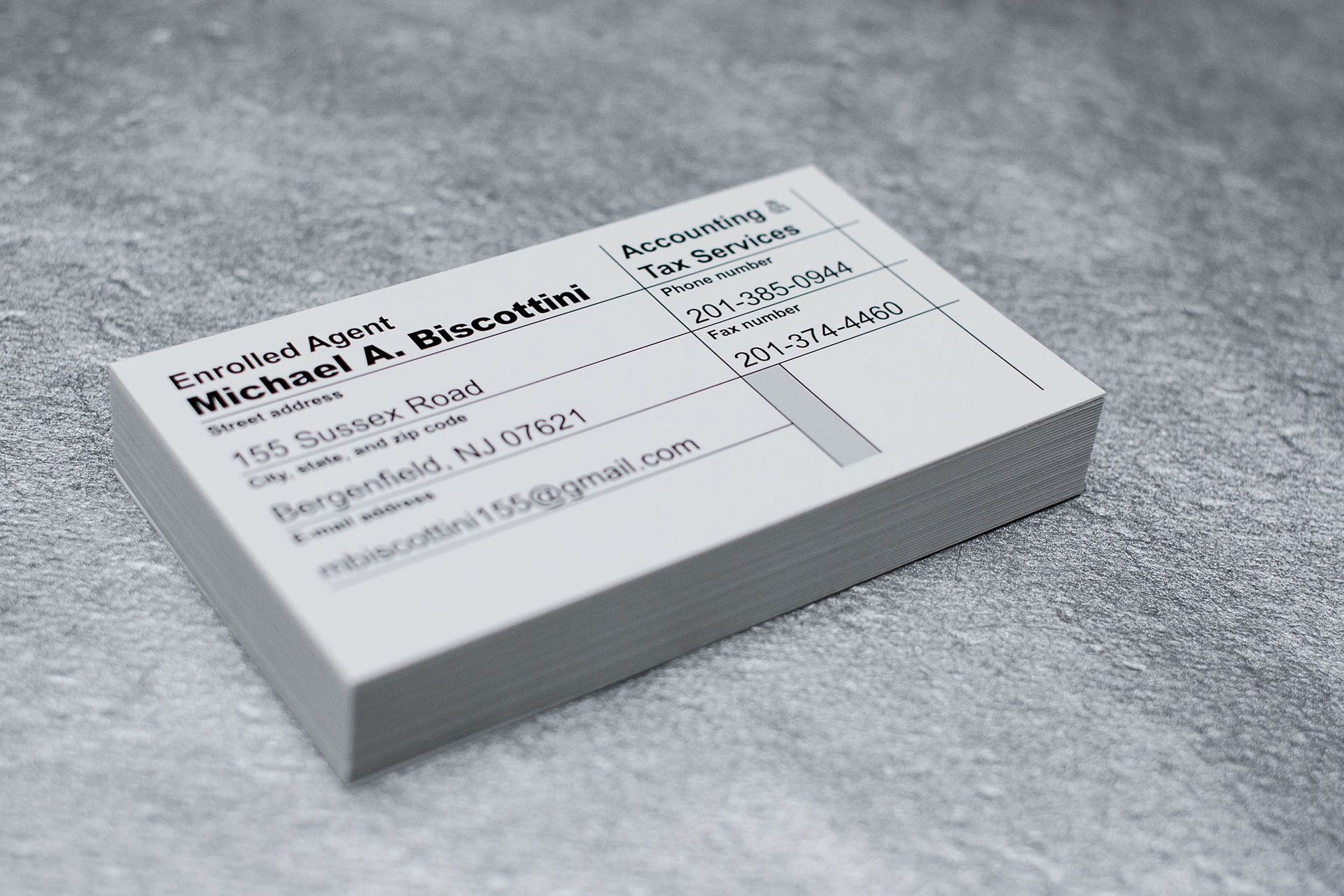
When it comes to running a successful tax preparation business, having a professional image can make a big difference. One way to project a professional image is by having well-designed business cards that reflect your expertise and credentials. For enrolled agents, in particular, having business cards that showcase your status as an authorized representative of the IRS can help you stand out from other tax preparers.
Enrolled agent business cards typically include the EA credential logo, which signifies that you have passed a rigorous exam or have extensive experience working for the IRS. This logo can help build trust with potential clients who may be looking for a qualified and knowledgeable tax professional. Additionally, your business cards can include your contact information, such as your phone number, email address, and website, so that clients can easily reach you when they need your services.
When designing your enrolled agent business cards, it is important to keep in mind that they should be professional and easy to read. Choose a font that is clear and legible, and use colors that are easy on the eyes. You may also want to consider including a brief tagline or slogan that highlights your unique value proposition as an enrolled agent. With a well-designed business card, you can make a strong first impression and attract more clients to your tax preparation business.
Basics of Enrolled Agent Business Cards

As an Enrolled Agent, your business card is a critical marketing tool that can help you attract prospective clients and communicate your professional expertise. Your business card should be designed to reflect your unique brand and convey your credentials, services, and contact information in a clear and concise way. Here are some basics to keep in mind when creating your Enrolled Agent business cards:
Design and Layout
Your business card design should be professional, clean, and easy to read. Consider using your logo or Enrolled Agent logo on your card to help establish your brand. Use high-quality images and choose fonts that are legible and easy to read, such as Lato. Keep in mind that your business card will often be the first impression that prospective clients have of your business, so make sure it represents you well.
Information to Include
Your business card should include your name, Enrolled Agent designation, and contact information, including phone number, email address, and website. You may also want to include a brief description of your services, such as tax preparation, representation, or planning. Keep in mind that your business card should be easy to read, so avoid cluttering it with too much information.
Black and White vs. Color
While color can make your business card stand out, it can also be more expensive to print. Consider using black and white for your business card design to save on printing costs. If you do choose to use color, make sure it is consistent with your brand and doesn’t distract from the information on your card.
File Format
When designing your business card, consider using a high-resolution JPG file format. This will ensure that your card looks crisp and clear when printed. You may also want to consider using a PDF file format to ensure that your design looks the same on all devices.
Communication
Your business card is a tool for communication, so make sure it conveys your message clearly and professionally. When handing out your business card, be sure to introduce yourself and explain your services. This can help establish a personal connection with prospective clients and increase the likelihood that they will contact you in the future.
In summary, your Enrolled Agent business card is an important marketing tool that should reflect your unique brand and convey your professional expertise. Keep in mind the design and layout, information to include, color options, file format, and communication when creating your business cards.
Becoming an Enrolled Agent


If you’re interested in becoming an Enrolled Agent (EA), there are a few steps you need to take to earn this credential. First, you must obtain a Preparer Tax Identification Number (PTIN) from the Internal Revenue Service (IRS). This is a unique identification number that is required for all tax return preparers.
Next, you’ll need to pass the Special Enrollment Examination (SEE). This is a three-part comprehensive exam that covers individual and business tax returns. You can find more information about the SEE on Prometric’s website, including test preparation resources and sample questions.
In addition to passing the SEE, you can also become an EA by gaining experience as a former IRS employee. This is known as the experience route to becoming an EA, and it requires a certain amount of experience working for the IRS in a position that involved the interpretation and application of the tax code.
Once you’ve become an EA, you’ll be able to represent taxpayers before the IRS. This means that you can assist clients with tax issues, such as audits, collections, and appeals. However, it’s important to note that there are rules and regulations that EAs must follow, including those outlined in Circular 230.
Circular 230 is a set of rules and regulations that govern the practice of EAs, as well as other tax professionals. These rules cover a wide range of topics, including ethical standards, practice before the IRS, and requirements for written advice. It’s important to be familiar with these rules and to follow them carefully in order to maintain your EA credential.
Overall, becoming an EA can be a challenging but rewarding process. Whether you choose to pursue this credential through the SEE or the experience route, you’ll gain valuable knowledge and skills that will help you assist clients with their tax issues.
Professional Guidelines and Regulations
As an Enrolled Agent, it is important to be aware of the professional guidelines and regulations that must be followed when creating business cards. These guidelines are set forth by the Internal Revenue Service (IRS) and Circular 230, which outlines the rules for practicing before the IRS.
Circular 230 rules state that an Enrolled Agent’s business card must comply with the regulations set forth in the circular. This means that the card should not contain any false or misleading information and should not imply any guarantees or promises of specific outcomes. Additionally, the card should not include any information that suggests a particular level of expertise or specialization, unless the Enrolled Agent has the necessary credentials to back up these claims.
It is also important to note that Enrolled Agents must have a Preparer Tax Identification Number (PTIN) in order to practice before the IRS. This number should be included on the business card along with the Enrolled Agent’s name and contact information.
Enrolled Agents who violate Circular 230 rules may face suspension or disbarment from practicing before the IRS. Therefore, it is crucial to adhere to these guidelines when creating business cards.
In addition to Circular 230 rules, Enrolled Agents should also be familiar with tax law and regulations. This knowledge can be useful when creating business cards that accurately reflect the Enrolled Agent’s expertise and services.
Overall, it is important to create a professional and informative business card that adheres to all guidelines and regulations set forth by the IRS and Circular 230. By doing so, Enrolled Agents can establish credibility and trust with potential clients while avoiding any potential disciplinary action.
Tools and Skills for Effective Business Cards


Your business card is your first impression on potential clients. It is essential to make sure that it is professional, informative, and easy to read. Here are some tools and skills that can help you create an effective business card:
Design Tools
There are many design tools available online that can help you create a professional-looking business card. Some popular options include Canva, Adobe Spark, and Vistaprint. These tools provide a wide range of templates, fonts, and colors that you can use to create a unique and eye-catching design.
Tax Matters
As an enrolled agent, it is important to make sure that your business card complies with Circular 230. This regulation sets standards for what can and cannot be printed on your card. Make sure that you include your name, the name of your firm, your EA designation, and your contact information. Avoid making any false or exaggerated claims about your services.
Skills
In addition to design tools, there are also some skills that you can develop to create an effective business card. These include:
- Writing skills: Make sure that your card is easy to read and understand. Use clear and concise language to describe your services.
- Marketing skills: Your business card is a marketing tool. Make sure that it accurately represents your brand and services.
- Attention to detail: Double-check your card for any spelling or grammatical errors. Make sure that all of your contact information is accurate and up-to-date.
Advertising
Your business card is not just a tool for networking. It can also be a powerful advertising tool. Make sure that you distribute your cards to potential clients, colleagues, and other professionals in your industry. You can also include your business card in your marketing materials, such as brochures or flyers.
Websites
In addition to your business card, you should also have a professional website that provides more information about your services. Include your website URL on your business card so that potential clients can easily find you online.
Pay.gov
If you need to apply for or renew your EA designation, you can do so through Pay.gov. This website allows you to pay your application fee online and track the status of your application. Make sure that you include your Pay.gov confirmation number on your business card so that potential clients can verify your status as an enrolled agent.
Cookies
Finally, consider including a small treat with your business card, such as a cookie or piece of candy. This can help make a lasting impression on potential clients and make your card stand out from the rest. Just make sure that you follow any relevant food safety regulations and avoid any potential allergens.
Once you have designed your business card, make sure that you save it as a PDF file. This will ensure that your card looks the same on all devices and can be easily printed.
By using these tools and skills, you can create an effective business card that accurately represents your brand and services.
Oliver dives into graphic design, branding, and marketing with passion. Beyond pixels and paper, he’s into boxing, CrossFit, and all things fitness. Oliver’s writing reflects his expertise and dedication to staying on top of industry trends.